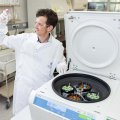A scramjet engine developed by British firm QinetiQ will be tested on Saturday, March 25, at the Defence-managed Woomera range at about 12.30pm South Australian local time as part of the HyShot™ experimental flight series.
The HyShot™ III flight is the first of two flights to be held at Woomera this month. The second flight, HyShot™ IV, is a joint collaboration between The University of Queensland and the Japanese Aerospace Exploration Agency (JAXA).
HyShot™ is an international space project led by The University of Queensland (UQ) which involves the launch of a Terrier Orion rocket fitted with a scramjet in an experiment at Woomera, 500km north of Adelaide.
Scramjets are air-breathing supersonic combustion ramjet engines. They are set to revolutionise the launch of small space payloads, such as communications satellites, by substantially lowering costs. They could make flights of only several hours between Australia and Britain possible.
Professor Allan Paull, of The University of Queensland`s Centre for Hypersonics, said that Australia had established an international standing in scramjet research. UQ reported for the first time in the open literature the development of a scramjet that achieved more thrust than drag in ground testing in 1993.
UQ also led the international HyShot™ program which demonstrated the world`s first supersonic combustion in an atmospheric flight test at Woomera on July 30, 2002, at speeds of more than Mach 8, or 8 times the speed of sound.
UQ is working towards several potential flights over the next few years to develop scramjet engine technology.
HyShot™ III has been prepared for flight at an estimated Mach 7.6 (7.6 times the speed of sound, or about 8000km/hour or 2.4km/sec). This is 10 times faster than conventional jet engines, with speeds of about 800km/hr.
It is hoped the experiment will validate information already captured in UQ`s T4 ground shock tunnel at St Lucia, one of the few facilities on earth capable of conducting ground based scramjet experiments for flight Mach numbers of the order of 8 or higher.
The scramjet engine has undergone extensive ground tests at the T4 shock tunnel.
Professor Paull said working with QinetiQ had been valuable as both groups shared the same objectives to see if the ground test results were comparable to tests in flight, and secondly, to gain first hand experience in preparing and flying a hypersonic vehicle.
The QinetiQ prototype is cylindrical with four combustors around the outside. The aerodynamics of the vehicle is improved by this arrangement.
It was cast from stainless steel where as engines in previous scramjet flights headed by UQ have been assembled from copper plates.
The HyShot™ project uses the expertise and financial support of consortium partners such as QinetiQ, Seoul National University, AFRL (US Air Force Research Laboratory), AFOSR (US Airforce Office of Scientific Research and AOARD (US Asian Office of Aerospace Research and Development) and Australian firms, including Alesi Technologies, Aimtek, Genova, and Swagelok. Funding has also been secured from the Australian Research Council.
NOTE:
The University of Queensland’s Centre for Hypersonics has the largest concentration of hypersonics researchers in the southern hemisphere. Hypersonics is the study of speeds Mach 5 and above. UQ has been developing scramjets for the past 25 years with funding from Australian, U.S., Japanese and German sources.
QinetiQ is one of Europe`s largest research organisations. Among its 11,500 staff, are scientists and engineers who lead their field and are internationally acclaimed experts. As its predecessor organisation, DERA, its pioneering research and development last century included the invention of liquid crystal displays (LCDs), carbon fibre, the technology for flat panel speakers, infra-red sensors and microwave radar.
Media: Further information, Jan King UQ Communications +61 413 601 248, j.king@uq.edu.au, Christopher Moseley, QinetiQ Press Office, +44 (0) 1252 395559, cgmoseley@qinetiq.com
Images: http://omc.uq.edu.au/images/HyShot2006/ (2006 flights) http://omc.uq.edu.au/images/HyShot2002/ (2002 flight)



